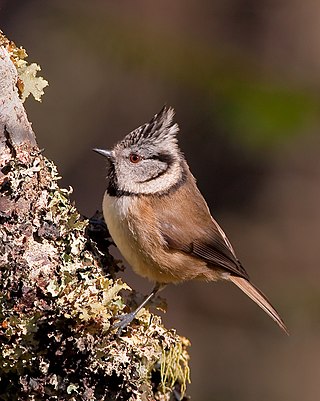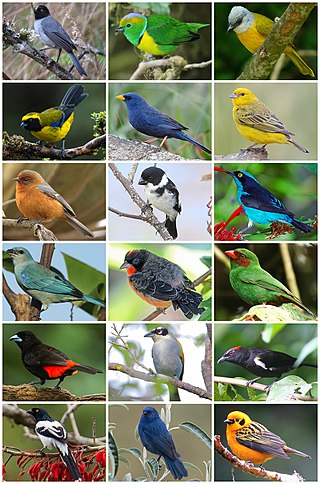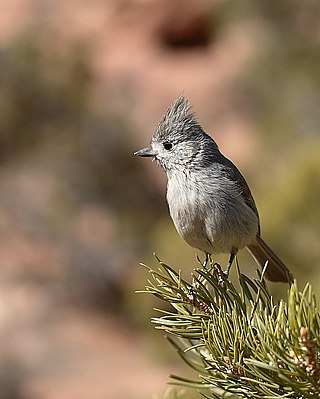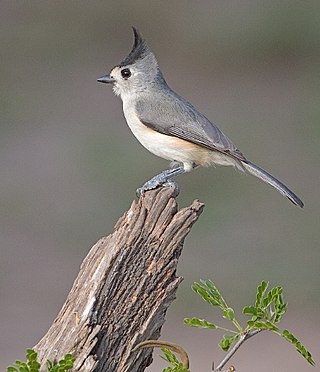
The blue jay is a passerine bird in the family Corvidae, native to eastern North America. It lives in most of the eastern and central United States; some eastern populations may be migratory. Resident populations are also in Newfoundland, Canada; breeding populations are found across southern Canada. It breeds in both deciduous and coniferous forests, and is common in residential areas. Its coloration is predominantly blue, with a white chest and underparts, and a blue crest; it has a black, U-shaped collar around its neck and a black border behind the crest. Males and females are similar in size and plumage, and plumage does not vary throughout the year. Four subspecies have been recognized.

The tits, chickadees, and titmice constitute the Paridae, a large family of small passerine birds which occur mainly in the Northern Hemisphere and Africa. Most were formerly classified in the genus Parus.

The tanagers comprise the bird family Thraupidae, in the order Passeriformes. The family has a Neotropical distribution and is the second-largest family of birds. It represents about 4% of all avian species and 12% of the Neotropical birds.

The veery is a small North American thrush species, a member of a group of closely related and similar species in the genus Catharus, also including the gray-cheeked thrush, Bicknell's thrush, Swainson's thrush, and hermit thrush. Alternate names for this species include Wilson's thrush and tawny thrush. Up to six subspecies exist, which are grouped into the eastern veery, the western veery or willow thrush, and the Newfoundland veery.

The white-breasted nuthatch is a species of bird in the nuthatch family Sittidae. It is a medium-sized nuthatch, measuring approximately 15.5 cm (6.1 in) in length. Coloration varies somewhat along the species' range, but the upperparts are light blue-gray, with a black crown and nape in males, while females have a dark gray crown. The underparts are whitish, with a reddish tinge on the lower abdomen. Despite not being closely related, the white-breasted nuthatch and the white wagtail are very similar in plumage. The white-breasted nuthatch is a noisy bird. It has a nasal voice and often utters little cries or vocalizations, often composed of repetitions of small invariant whistles. In summer, it is an exclusively insectivorous bird, consuming a wide range of arthropods, but in winter its diet consists mainly of seeds. The nest is located in the cavity of a tree. The clutch consists of five to nine eggs, incubated for two weeks by the female, who is fed by the male. The two adults then feed the young until they fledge, and for a few weeks after that.

The black-capped chickadee is a small, nonmigratory, North American passerine bird that lives in deciduous and mixed forests. It is a member of the Paridae family, also known as tits. It has a distinct black cap on its head, a black bib underneath, and white cheeks. It has a white belly, buff sides, and grey wings, back, and tail. The bird is well known for its vocalizations, including its fee-bee call and its chick-a-dee-dee-dee call, from which it derives its name.

Margaret Morse Nice was an American ornithologist, ethologist, and child psychologist who made an extensive study of the life history of the song sparrow and was author of Studies in the Life History of the Song Sparrow (1937). She observed and recorded hierarchies in chicken about three decades ahead of Thorleif Schjelderup-Ebbe who coined the term "pecking order". After her marriage, she made observations on language learning in her children and wrote numerous research papers.

The Carolina chickadee is a small passerine bird in the tit family Paridae.

The mountain chickadee is a small songbird, a passerine bird in the tit family Paridae.

The Mexican chickadee is a small songbird, a passerine bird in the tit family Paridae. It is still often placed in the genus Parus with most other tits, but mtDNA cytochrome b sequence data and morphology suggest that separating Poecile more adequately expresses these birds' relationships. The American Ornithologists' Union had been treating Poecile as distinct genus for some time already.

The oak titmouse is a passerine bird in the tit family Paridae. The American Ornithologists' Union split the plain titmouse into the oak titmouse and the juniper titmouse in 1996, due to distinct differences in song, preferred habitat, and genetic makeup.

The juniper titmouse is a passerine bird in the tit family Paridae. The American Ornithologists' Union split the plain titmouse into the oak titmouse and the juniper titmouse in 1996, due to distinct differences in song, preferred habitat, and genetic makeup.

The chestnut-backed chickadee is a small passerine bird in the tit family, Paridae, native to western North America.

The black-crested titmouse or Mexican titmouse, is a passerine bird in the tit family Paridae. Once considered a subspecies of the tufted titmouse, it was recognized as a separate species in 2002. It is native to southern Texas, Oklahoma, and east-central Mexico. Vagrants have been seen as far north and east as St. Louis, Missouri.

The bridled titmouse is a small songbird, a passerine bird in the tit family Paridae.

Baeolophus is a genus of birds in the family Paridae, commonly called tits. Its members are known as titmouses or titmice. All the species are native to North America. In the past, most authorities retained Baeolophus as a subgenus within the genus Parus, but treatment as a distinct genus, initiated by the American Ornithological Society, is now widely accepted.
Amelia Rudolph Laskey was an American amateur naturalist and ornithologist noted for her contributions to the understanding of bird behavior. Though an autodidact without formal scientific training, Laskey made many original contributions to the field of ornithology and published in reputable scientific journals. Many publications refer to her as Mrs F.C. Laskey.






















